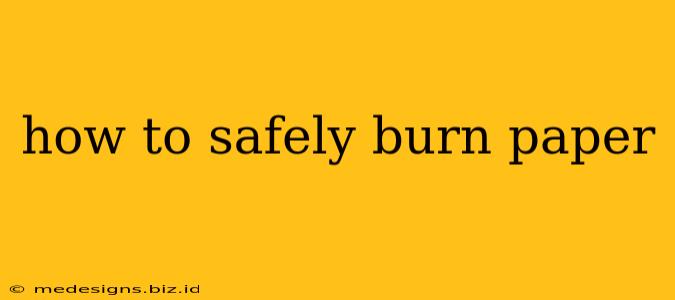Burning paper might seem simple, but doing it safely requires careful planning and execution. Whether you're conducting a small ceremonial burning, disposing of sensitive documents, or engaging in a controlled fire for artistic purposes, understanding the safety precautions is crucial. This comprehensive guide will walk you through the process, ensuring you burn paper responsibly and without incident.
Preparing for a Safe Paper Burning
Before you even strike a match, preparation is key to a safe paper burning experience. This involves choosing the right location, gathering necessary materials, and understanding potential risks.
1. Choosing the Right Location:
- Outdoor Space: Always prioritize an outdoor location. This minimizes the risk of fire spreading and reduces the chance of smoke inhalation. Open areas away from buildings, dry grass, and overhanging branches are ideal.
- Designated Fire Pit or Container: A dedicated fire pit or a metal container designed for burning is highly recommended. Never burn paper directly on the ground. This prevents accidental ground fires and contains the ashes.
- Wind Conditions: Check the weather forecast. Avoid burning on windy days, as embers can easily be carried away and start unwanted fires. Calm conditions are essential.
- Water Source: Always have a readily available water source (bucket, hose) nearby to extinguish the fire quickly if necessary.
2. Gathering Necessary Materials:
- Matches or Lighter: Opt for long matches or a reliable lighter to avoid burns.
- Kindling: Small pieces of easily combustible material like dry twigs or paper scraps can help start the fire.
- Paper to be Burned: Organize the paper neatly; avoid large stacks that might smolder instead of burning cleanly.
- Fire Extinguisher (Recommended): While a water source is crucial, a small fire extinguisher provides extra safety, especially for larger burning sessions.
The Burning Process: Step-by-Step
Once you've prepared your location and gathered your materials, you can begin the controlled burning process.
1. Build a Small Fire:
Create a small fire using kindling, ensuring it's established before adding the paper. A larger fire isn't necessary; a controlled burn is safest.
2. Add Paper Gradually:
Add the paper to the fire gradually, allowing each piece to catch fire completely before adding more. Avoid overloading the fire, which can lead to incomplete burning and lingering embers.
3. Monitor the Fire Continuously:
Never leave the fire unattended. Continuously monitor the burning process, ensuring the flames are contained and the fire is burning completely.
4. Extinguishing the Fire:
Once the paper is completely burned, allow the embers to cool completely before dousing them with water. Stir the ashes with a shovel or sturdy stick to ensure all embers are extinguished. Make certain there's no lingering smoke or heat before leaving the area.
Safety Precautions and Important Considerations:
- Never burn anything flammable near the fire: Keep flammable materials like gasoline, propane, or other chemicals far away from the burning area.
- Keep children and pets away: Maintain a safe distance from the fire to protect children and pets from burns or injury.
- Check local regulations: Some areas have restrictions on open burning. Check with your local authorities before commencing any fire.
- Air Quality: Be mindful of air quality, especially if burning large amounts of paper. Smoke can be harmful to health. Consider the wind direction.
- Disposal of Ashes: After the fire is completely extinguished and cooled, properly dispose of the ashes in a non-flammable container.
By following these guidelines, you can safely burn paper while minimizing risks. Remember that safety is paramount. If you have any doubts about your ability to manage a controlled burn, it's best to err on the side of caution and seek alternative methods for paper disposal.
